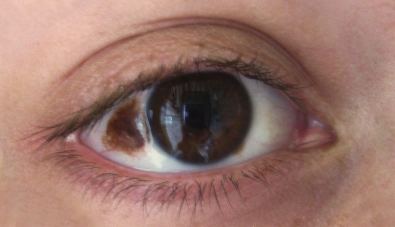Specialty oncology DiseasesDB 32588 MeSH D009507 | ICD-10 D22.3 (ILDS D22.301) eMedicine DERM/290 | |
 | ||
Nevus of Ota (also known as "congenital melanosis bulbi", "nevus fuscoceruleus ophthalmomaxillaris", "oculodermal melanocytosis", and "Oculomucodermal melanocytosis") is a blue hyperpigmentation that occurs on the face. It was first reported by Dr. M.T. Ota of Japan in 1939.
Contents
Nevus of Ota is caused by the entrapment of melanocytes in the upper third of the dermis. It is found on the face unilaterally and involves the first two branches of the trigeminal nerve. The sclera is involved in two-thirds of cases (causing an increased risk of glaucoma). It should not be confused with Mongolian spot, which is a birthmark caused by entrapment of melanocytes in the dermis but is located in the lumbosacral region. Women are nearly five times more likely to be affected than men, and it is rare among Caucasian people. Nevus of Ota may not be congenital, and may appear during puberty.
Skin treatment
A Q-switched laser has been successfully used to treat the condition.
Eye treatment
A specific form of conjunctivoplasty may help somewhat.
